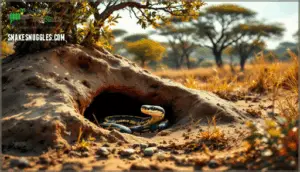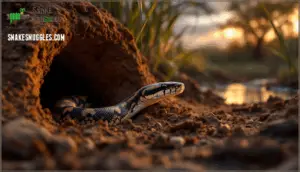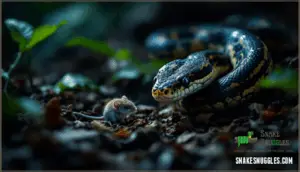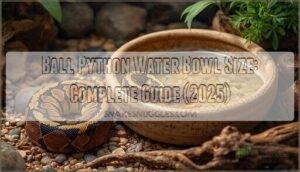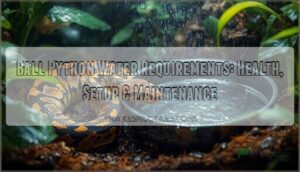This site is supported by our readers. We may earn a commission, at no cost to you, if you purchase through links.
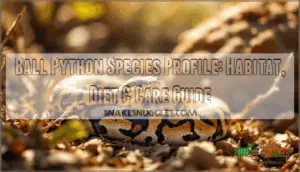
With over 3 million individuals traded globally since 1975 and hundreds of captive-bred color morphs now available, understanding the species’ wild ecology, hunting adaptations, and conservation needs has never been more relevant for both keepers and conservationists alike.
Table Of Contents
- Key Takeaways
- Ball Python Species Overview
- Natural Habitat and Geographic Range
- Diet, Hunting, and Feeding Habits
- Reproduction, Development, and Lifespan
- Conservation Status and Human Impact
- Frequently Asked Questions (FAQs)
- Are ball pythons good pets for kids?
- How much does a ball python cost?
- Do ball pythons bite or harm humans?
- Can ball pythons be kept with other pets?
- How often do ball pythons need handling?
- How often do ball pythons shed their skin?
- Can ball pythons swim or tolerate water?
- What temperature range do ball pythons need?
- Are ball pythons venomous or dangerous to humans?
- Conclusion
Key Takeaways
- Ball pythons are native to 18 West and Central African countries, where they’ve adapted to semi-arid savannas by using rodent burrows and termite mounds as thermal refuges, hunting nocturnally with heat-sensing pits to locate prey that’s 1.0-2.0 times their head width.
- Over 3 million ball pythons have entered global trade since 1975, with the species now listed as near threatened due to habitat loss, agricultural expansion, and collection pressure that’s reduced daily harvest rates in some regions from 10 snakes to fewer than one.
- These constrictors display marked sexual dimorphism—females mature slower (27-31 months versus 16-18 months for males) and grow significantly larger, while selective breeding has produced hundreds of color morphs that command premium prices in a market supporting over 1.3 million captive animals in the U.S. alone.
- Wild ball pythons average 10-year lifespans compared to 20+ years in captivity, demonstrating how controlled environments with consistent feeding, veterinary care, and optimized husbandry dramatically extend longevity beyond what predation pressure and resource scarcity allow in their natural habitat.
Ball Python Species Overview
Ball pythons belong to a fascinating group of constrictors that have captivated reptile enthusiasts for decades. Understanding their scientific background, physical traits, and natural temperament will help you appreciate what makes this species unique.
Let’s look at the essential characteristics that define ball pythons as both wild animals and popular captive specimens.
Scientific Classification
You’ll know the ball python by its formal designation: Python regius, a taxonomic label that places this docile constrictor within the family Pythonidae and marks it as one of Africa’s most recognizable serpent species. The naming conventions reflect its regal demeanor—regius translates to "royal" in Latin.
Ball pythons share genetic lineage with other python species, though subspecies debate remains minimal due to consistent ball python biology across their range. Evolutionary relationships link them closely to related African pythons, solidifying their position within Python genus taxonomy.
Key Physical Characteristics
Ball python physical characteristics are immediately recognizable: adults reach 90 to 137 cm in length, though females consistently outsize males by several inches. Their stocky body proportions—often exceeding several inches in diameter—pair with a disproportionately small head covered in smooth, glossy scales. Scale morphology remains consistent across wild populations, displaying black or dark brown base coloration overlaid with lighter brown to gold blotches, while the ventral surface presents white or cream hues.
Sexual dimorphism extends beyond size variations; males exhibit thicker tails housing hemipenes, and probe depths differ markedly between sexes.
Selective breeding has produced hundreds of color morphs, including albino, pastel, and piebald variations that dramatically alter ball python appearance and market value. These snakes are popular in the pet trade because of their relatively small size.
Behavior and Temperament
Beyond their distinctive appearance, these pythons exhibit docile temperament traits that have cemented their status as one of the most widely kept reptile species in private collections worldwide. Their nocturnal behavior means they’re most active after sunset, when they hunt using thermal detection.
Ball python behavior includes a characteristic defensive mechanism—curling into a tight ball when threatened—rather than striking aggressively. This docile nature and ease of management make captive adaptations remarkably successful, though you’ll notice they may refuse food during seasonal breeding cycles or stress periods.
Natural Habitat and Geographic Range
Ball pythons evolved across a wide geographic stretch of Africa, shaping their behavior and habitat preferences in ways that matter when you’re setting up their care. Understanding where they come from—and what environments they naturally seek out—gives you a foundation for meeting their needs in captivity.
Let’s look at the regions they call home, the ecosystems they prefer, and how they’ve adapted to survive in the wild.
Native Countries and Regions
In West and Central Africa, your ball python’s wild ancestors roam across 18 countries—from Senegal and Mali eastward through Ghana, Nigeria, and Cameroon, all the way to Uganda and Sudan’s Nuba Mountains. This African distribution spans regions just south of the Sahara to near the Equator, though tropical rainforest belts act as regional barriers, fragmenting populations.
Cultural protection in Benin, Togo, and Ghana has preserved local concentrations, while conservation efforts address habitat fragmentation affecting the species’ geographic range across its native habitat. They’re commonly found in dry savannas and open forests.
Preferred Ecosystems
Your ball python thrives in semi-arid savannas and grasslands where scattered trees, scrubby vegetation, and seasonal moisture create a mosaic of hunting grounds and thermal refuges. These savanna adaptation zones blend open terrain with forest habitats at woodland edges, providing critical water access during wet seasons.
Regional variations in Ball Python ecology reflect burrowing behavior—they occupy abandoned rodent tunnels and termite mounds throughout their geographic range, optimizing Ball python habitat use across diverse ecosystems.
Shelter and Environmental Adaptations
Tucked beneath the surface of West African savannas, these serpents commandeer rodent burrows and termite mounds as ready-made refuges that stabilize body temperature and shield them from predators. This burrowing behavior satisfies thermoregulation needs—you’ll find them emerging at dusk to hunt near water sources, then retreating underground when temperatures spike.
Their camouflage techniques and habitat specificity reflect precise ball python behavior: mottled brown scales blend seamlessly with leaf litter, while proximity to animal burrows guarantees both thermal regulation and access to prey corridors essential for ball python care in captive settings.
Diet, Hunting, and Feeding Habits
Ball pythons are opportunistic predators with a specialized approach to finding and capturing their meals. Their nocturnal lifestyle and unique sensory abilities make them efficient hunters in the African savanna.
Understanding how these snakes locate, capture, and consume prey reveals the striking adaptations that have allowed them to thrive in their native range.
Typical Prey in The Wild
In the wild, Ball Python diet and feeding habits reveal a fascinating split between age groups. Juvenile diet leans heavily toward small birds—nestlings and fledglings—while adult diet shifts to rodents like African giant rats and black rats, which compose over 65% of prey. Prey size generally matches 1.0–2.0 times head width.
Seasonal variation and regional differences also shape Ball python food habits and predation patterns.
Hunting Techniques and Nocturnal Activity
Once darkness falls, ball pythons shift from motionless observers to active predators, relying on stealth and patience rather than speed. Their nocturnal patterns center on ambush-style hunting behavior—positioning themselves near rodent burrows or game trails, waiting for prey to venture within striking range.
Key hunting techniques include:
- Thermal detection through heat-sensing pits along their upper lip, allowing precise prey location in complete darkness
- Constriction methods that suffocate prey within minutes, applying calculated pressure until cardiac arrest occurs
- Prey selection based on size assessment, targeting animals matching 1.0–2.0 times their head width for optimal hunting success
- Strike-and-hold strategy where needle-sharp teeth anchor prey before coiling begins, minimizing escape opportunities
This nocturnal predator achieves considerable predation efficiency through these coordinated behaviors.
Sensory Adaptations for Predation
Beyond vision alone, ball pythons possess a complex sensory toolkit that transforms them into precision-guided nocturnal hunters—detecting prey through channels entirely invisible to human perception. Heat sensing pits lining their upper lip generate thermal images of warm-blooded targets, while their Jacobson’s Organ processes chemical signatures collected by tongue-flicking behavior.
These dual systems enable accurate prey detection during nocturnal hunting, guiding constriction tactics that make this predator remarkably effective despite its deliberate pace and seemingly simple diet preferences.
Reproduction, Development, and Lifespan
Ball pythons follow a predictable reproductive cycle that’s shaped by seasonal patterns in their native West African habitat. Understanding when these snakes reach maturity, how they produce offspring, and how long they live can help you appreciate their life cycle whether you’re studying them in the wild or caring for them in captivity.
Let’s look at the key stages from breeding season through their full lifespan.
Breeding Season and Maturity
If you’re keen to breed ball pythons, you’ll need to understand that sexual maturity doesn’t arrive on the same timeline for males and females—a difference that directly impacts your breeding program’s success. Males reach reproductive health between 16 and 18 months, while females take longer, maturing between 27 and 31 months.
Ball python breeding season runs from mid-September through mid-November, when reproductive behavior peaks naturally.
Clutch Size and Incubation
After that breeding window closes, you’ll find that female ball pythons lay clutches of 4 to 15 eggs, with regional variation—6 to 15 in Ghana, 4 to 8 in Benin and Togo.
Successful ball python reproduction depends on three critical factors:
- Maintaining incubation temperature at 31.7°C (89°F)
- Keeping humidity levels at 95%
- Monitoring egg development for 55-60 days
Parental care is minimal post-laying, though females may coil around their clutch of eggs initially, and hatchling success improves when breeders assist emergence in over half of captive cases.
Lifespan in The Wild Vs. Captivity
You’ll notice a striking difference in ball python life expectancy between environments—wild populations average around 10 years, while captive specimens routinely reach 20 years or more.
This longevity gap stems from environmental impact factors like predation pressure and resource scarcity in their natural habitat, plus care differences including consistent feeding schedules, veterinary access, and optimized husbandry that captive ball pythons receive. Genetic factors play a minimal role compared to these environmental variables.
Conservation Status and Human Impact
While ball pythons aren’t currently endangered, their populations face growing pressure from habitat changes and collection for international trade. Understanding these challenges helps you appreciate the delicate balance between conservation needs and the species’ economic importance in both their native range and the global pet industry.
Let’s examine how human activity shapes the prospects of these fascinating constrictors.
Current Population Trends
Wild ball python populations face a downward trajectory. Field data from West Africa document a sustained decline since 2010, driven by habitat loss and collection pressure.
Over 3 million individuals have entered global trade since 1975, with annual exports from Togo alone averaging 55,000 pythons.
Since 1975, more than 3 million ball pythons have entered global trade, with Togo alone exporting an average of 55,000 annually
The IUCN now lists this species as near threatened, reflecting conservation concerns across its native distribution in 18 African countries.
Threats and Conservation Efforts
Multiple pressures converge on ball python conservation. Three primary threats shape current wildlife conservation strategies:
- Trade overexploitation continues as hundreds of thousands leave West Africa annually despite CITES Appendix II protections, with Benin reporting daily harvest rates plummeting from 10 snakes to fewer than one.
- Habitat degradation accelerates through slash-and-burn agriculture and mechanized farming across deforested landscapes.
- Medicinal uses compound collection pressure beyond documented exports.
Regulatory challenges persist—inconsistent monitoring hinders IUCN assessments.
Conservation efforts now emphasize ranching programs and community education to balance livelihood needs with ball python conservation status improvements.
Role in Pet Trade and Local Economies
The ball python industry generates millions annually, weaving together African livelihoods and a thriving global reptile market that now sustains over 1.3 million captive animals in the United States alone. Export quotas regulate sustainable harvesting from countries like Togo, which ships over 10,000 specimens yearly. Ethical considerations now drive morph market trends, where designer genetics command premium prices while supporting captive ball python care standards that make them a beginner pet of choice.
| Economic Aspect | Impact |
|---|---|
| U.S. Captive Population | 1.3+ million animals |
| Annual Togo Exports | 10,000+ specimens |
| Median Breeder Inventory | 45 animals |
| Historical Export Volume | 30,000-50,000/year |
Ball python popularity reshapes both conservation funding and rural incomes, demonstrating the economic importance of balancing trade with species protection.
Frequently Asked Questions (FAQs)
Are ball pythons good pets for kids?
Scaling up your child’s responsibility? Ball pythons can work as beginner pets for older kids with proper parental supervision and education.
You’ll need to think about bite risk, age appropriateness, and commitment to reptile care in a captive environment before bringing one home.
How much does a ball python cost?
You’ll find ball pythons priced from around $50 for standard morphs in the pet trade to thousands for designer variants. Morph price depends on genetics—rare patterns command premium import costs.
Budget for maintenance expenses, veterinary care, and habitat setup beyond the purchase. These beginner pets offer long-term value as reptile care investments.
Do ball pythons bite or harm humans?
Ball Pythons are nonvenomous constrictors and rarely bite humans, making them generally safe. While their protective mechanism can trigger defensive behavior if threatened, bites are usually minor and pose minimal risks when interacting with them compared to other snake species.
Can ball pythons be kept with other pets?
You shouldn’t house ball pythons with other pets due to predator-prey risk and temperament compatibility issues. Supervision is needed during any interaction.
Captive ball python care requires separate enclosures to maintain hygiene concerns and proper snake care protocols.
How often do ball pythons need handling?
You’ll want to pick up your ball python about once or twice weekly—frequent enough to maintain their temperament without triggering stress indicators.
Proper holding depends on owner experience and reading Ball Python behavior carefully, as these captive ball python care essentials differ from their pet trade origins where minimal contact occurs.
How often do ball pythons shed their skin?
Shedding frequency varies—young ball pythons shed every 4-6 weeks as they grow rapidly, while adults usually shed every 6-8 weeks.
Factors affecting this include growth rate, humidity levels, and overall health, with signs of shedding appearing as cloudy eyes and dull skin coloration.
Can ball pythons swim or tolerate water?
Yes, ball pythons can swim, though they aren’t naturally aquatic. In their native habitat, they encounter water sources and will soak, especially during shedding.
Proper humidity levels support hydration needs and act as a shedding aid, but always monitor for drowning risk.
What temperature range do ball pythons need?
You’ll want to maintain thermal gradients in your ball python’s enclosure, with basking spots reaching 88-92°F and a cooler side around 78-80°F. Night temperatures can safely drop to 72-75°F.
Heating methods like under-tank heaters or ceramic bulbs help create these essential zones, mimicking the natural temperature variations ball pythons experience in their native African savannas.
Are ball pythons venomous or dangerous to humans?
No, ball pythons aren’t venomous snakes and pose minimal threat to humans. While they can bite when stressed, these constrictors lack venom and rarely show aggression.
Their constriction behavior targets small prey, not people, making interaction safe with proper techniques.
Conclusion
From sprawling West African grasslands to glass terrariums across six continents, the ball python has traveled an extraordinary path. This thorough ball python species profile reveals a species shaped by survival in harsh semi-arid ecosystems—thriving on patience, precision, and remarkable adaptability.
Whether you’re drawn to their docile temperament, fascinated by their heat-sensing capabilities, or committed to responsible captive care, understanding their wild origins remains essential. These constrictors remind us that proper husbandry doesn’t just replicate habitat—it honors millions of years of evolutionary refinement.
- https://en.wikipedia.org/wiki/Ball_python
- https://animaldiversity.org/accounts/Python_regius/
- https://www.dimensions.com/element/ball-python-python-regius
- https://cites.org/sites/default/files/vc-files/files/assessment_impact_pet_trade_case_study_Python_regius.pdf
- https://bioone.org/journalArticle/Download?urlId=10.5818%2FJHMS-05-2020


